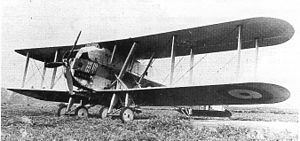Top speed 185 km/h Length 16 m | Wingspan 27 m First flight 1924 | |
 | ||
The Blackburn T.4 Cubaroo was a prototype British biplane torpedo bomber of the 1920s. Built by Blackburn Aircraft and intended to carry a large 21 in (533 mm) torpedo, the Cubaroo was one of the largest single-engined aircraft in the world at the time of its first flight.
Contents
Design and development
In 1921, the British Air Ministry issued Specification 8/21 to Blackburn for a Coastal Defence Torpedo Aeroplane, the resulting design being designated the T.4 Cubaroo. Due to the change of policy in the Air Ministry to favour a twin-engined design a new sepcification was issued in 1922, the British Air Ministry drew up Specification 16/22, for a long-range torpedo bomber capable of carrying a 21 in (533 mm) torpedo (which was at the time thought capable of sinking the largest warship) over a range of 800 mi (1,300 km). Major F. A Bumpus, chief designer of Blackburn Aircraft submitted the design for the Blackburn T.4 Cubaroo, which was a large biplane powered by a single example of the new 1,000 hp (750 kW) Napier Cub engine. Avro also submitted a design against this specification, the Avro 557 Ava, which was a similarly large biplane, powered by two 600 hp (450 kW) Rolls-Royce Condor engines.
In order to carry the heavy (over 2,000 lb/907 kg) torpedo over a long range, the Cubaroo was massive. With a wingspan of 88 ft (27 m), it may have been the largest single-engine military aircraft in the world at the time, and was fitted with the most powerful aircraft engine available, the Napier Cub, which was an unusual X-type engine which weighed over a ton excluding radiators. The Cubaroo, with a mainly metal structure, had a deep fuselage to accommodate the Cub engine, and was fitted with folding, two-bay wings. In order to allow the torpedo to be carried, the Cubaroo was fitted with a main undercarriage comprising two sets of two wheels, with the torpedo being carried on a crutch between the two sets of wheels.
Operational history
The first prototype (with serial N166) flew in secrecy in the summer of 1924, proving to have good handling characteristics, with the engine not causing problems (the Cub had already been test flown in an Avro Aldershot testbed). It was then fitted with a metal, three-blade adjustable-pitch propeller and was delivered for testing at RAF Martlesham Heath, but was written off after its undercarriage collapsed on 2 February 1925. A second prototype flew in 1925, but the Air Ministry abandoned the requirement for a torpedo bomber to carry the 21 in (533 mm) torpedo, and lost interest in single-engine heavy bombers, so the second prototype Cubaroo was used as an engine testbed, flying with the experimental 1,100 hp (820 kW) Beardmore Simoon compression ignition engine.
Operators
Specifications (Cubaroo)
Data from The British Bomber since 1914
General characteristics
Performance
Armament
or
